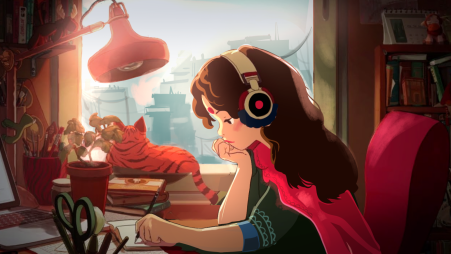Why Lo-Fi music is reigning in this generation's playlist

Lo-Fi music – previously an underground genre – has become a new cultural phenomenon amongst millennials and Gen Z across the world. From relaxing on a rainy Friday to pulling an all-nighter before a deadline, Lo-Fi music creates the perfect ambience to boost your mood or pump your level of productivity. As a huge Ghibli fanatic, I love listening to Ghibli Lo-Fi mix and it helps me deal with anxiety. Naturally, I thought it was worth delving into how Lo-Fi came to have its current hold on the internet.
The steady beats of Lo-Fi have replaced classical music in its ability to help people focus better. In fact, there was no significant psychological difference between listening to Lo-Fi or classical music, according to a recent study published in the Kwantlen Psychology Student Journal. The research furthermore shows that neither form of music was better or worse than the silence which makes it the ideal music for studying.
We know Hi-Fi (High fidelity) music refers to the music that is polished till it's perfect. Mainstream songs fall under this category. The opposite of that is Lo-Fi (low-fidelity) music, created with imperfections in its audio. Background noises, electric hip-hop beats, and downtempo rhythms are the basic elements of Lo-Fi tracks and they do not require a lot of resources to create.
Promoted with the labels like study music, stress reliever, relaxing, calming etc, the concept of Lo-Fi has become popular in the last decade thanks to platforms like YouTube and Spotify.
Nujabes, a Japanese DJ and producer, known as the pioneer of Lo-Fi, created a unique sound by fusing elements of hip-hop, jazz, and electronica in Japanese songs. Lo-Fi hip-hop has a clear link to Japan because of him. His creations contain the bittersweet reminiscence that is still a huge thematic influence on Lo-Fi.
Arshee Joarder, a student at the University of Dhaka is a trained classical singer. However, she shared that she enjoys different Lo-Fi remixes of old songs as much as classics, because of their soothing rhythm.
"It has now become a trend to revive and make lofi remixes of popular songs, some renowned channels on YouTube do great in terms of remixing those songs. The fusions of contemporary beats do help me to create the right mindset before studying. Moreover, the livestream Lo-Fi helps me to communicate with a community and chat with them. I mostly enjoy the indie Lo-Fi tracks and my favourite channel is The Jazz Hop café."
A common feature of these Lo-Fi music videos is a girl studying eternally, from day to night beside her window. Commonly known as the Lo-Fi girl, her actual name is the study girl invented by The Chilled Cow, one of the popular YouTube channels for Lo-Fi livestreams. The artwork is originally inspired by the Ghibli anime 'Whisper of the Heart' and created by Juan Pablo Machado.
Later on, many versions of the Lo-Fi girl inundated the internet where more or less everyone is seen as studying or chilling in their room. Lo-Fi is correlated to reducing anxiety and boosting dopamine, hence in a complex world like today's Lo-Fi has become a therapeutic reprieve.
Lo-Fi music is designed to be easy to listen to, creatively collaborating multiple genres without compromising the original.
The Lo-Fi remix of the popular Rabindra Sangeet 'Majhe Majhe Tobo Dekha Pai' has over 5.2 million viewers which impacted the Lo-Fi scene in Bangladesh greatly. It is a creation by Mashuq Haque, one of the more popular Lo-Fi artists of Bangladesh. He has over 110,000 subscribers on YouTube, Mashuq also created Lo-Fi versions of Bedona by Shunno, Alo by Tahsan, Amar Dehokhan by Odd Signature all of which have at least a million views each
The Business Standard reached Mashuq to learn a bit more about his work on Bangla Lo-Fi music.
Mashuq started making Lo-Fi Music in 2020 by remixing Pritom Hasan's 'Bhenge Porona'. He had noticed a weird algorithmic change on his youtube channel. Since then, he hasn't stopped remixing songs. Before that, he was into fully Orchestral Cinematic music due to his education as a Music Producer.
"I started learning Music back in 2010 by exchanging a phone for a musical keyboard with a friend of mine and I believe that was the best trade of my life. I was a high schooler back then, later I joined and performed with Bands like Nova, Radioactive, Exenemy, Rajotto etc as a Keyboard player," said Mashuq.
Mashuq shared that his production skills went up a notch when he contracted Coronavirus and also discovered that Lo-Fi motifs lend themselves well to Bangla music, he has achieved widespread recognition as a result and has never looked back since.
Lo-Fi has given birth to subgenres like 'slowed and reverb' which is also popular among youth. With its ambiance-altering abilities Lo-Fi vibes will continue to rule our playlists.
TBS Picks for Lo-Fi channels:
- Mashuq Haque for Bangla Lo-Fi mix
- Lofi Girl for mood based Lo-Fi hip hop
- The Jazz Hop Café for chilled anime mix
- Lo-Fi music for retro mix
- WORMONO for hindi mix


 Keep updated, follow The Business Standard's Google news channel
Keep updated, follow The Business Standard's Google news channel















